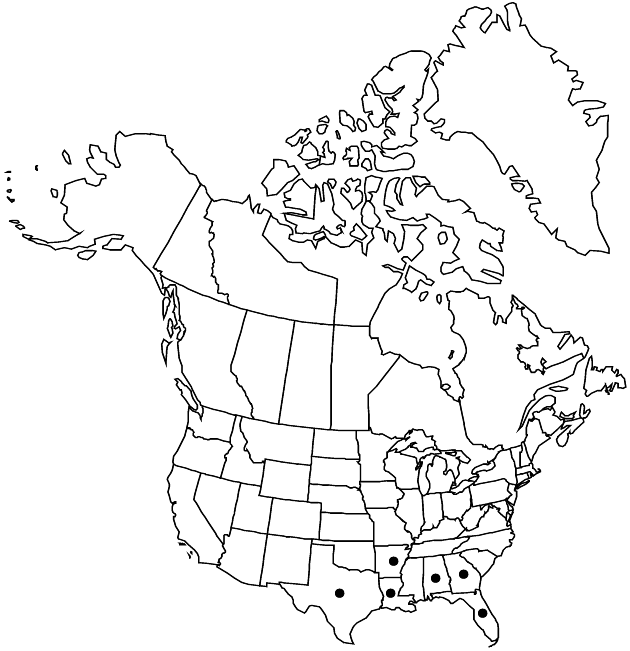Difference between revisions of "Heliopsis gracilis"
Trans. Amer. Philos. Soc., n. s. 7: 353. 1840.
FNA>Volume Importer |
imported>Volume Importer |
||
| (3 intermediate revisions by 2 users not shown) | |||
| Line 8: | Line 8: | ||
}} | }} | ||
|common_names=Smooth or pinewoods oxeye | |common_names=Smooth or pinewoods oxeye | ||
| + | |special_status={{Treatment/ID/Special_status | ||
| + | |code=E | ||
| + | |label=Endemic | ||
| + | }} | ||
|basionyms= | |basionyms= | ||
|synonyms={{Treatment/ID/Synonym | |synonyms={{Treatment/ID/Synonym | ||
|name=Heliopsis helianthoides var. gracilis | |name=Heliopsis helianthoides var. gracilis | ||
|authority=(Nuttall) Gandhi & R. D. Thomas | |authority=(Nuttall) Gandhi & R. D. Thomas | ||
| + | |rank=variety | ||
}} {{Treatment/ID/Synonym | }} {{Treatment/ID/Synonym | ||
|name=Heliopsis laevis var. minor | |name=Heliopsis laevis var. minor | ||
|authority=Hooker | |authority=Hooker | ||
| + | |rank=variety | ||
}} {{Treatment/ID/Synonym | }} {{Treatment/ID/Synonym | ||
|name=Heliopsis minor | |name=Heliopsis minor | ||
|authority=(Hooker) C. Mohr | |authority=(Hooker) C. Mohr | ||
| + | |rank=species | ||
}} | }} | ||
|hierarchy=Asteraceae;Asteraceae tribe Heliantheae;Asteraceae (tribe Heliantheae) subtribe Ecliptinae;Heliopsis;Heliopsis gracilis | |hierarchy=Asteraceae;Asteraceae tribe Heliantheae;Asteraceae (tribe Heliantheae) subtribe Ecliptinae;Heliopsis;Heliopsis gracilis | ||
| Line 33: | Line 40: | ||
|elevation=0–100 m | |elevation=0–100 m | ||
|distribution=Ala.;Ark.;Fla.;Ga.;La.;Tex. | |distribution=Ala.;Ark.;Fla.;Ga.;La.;Tex. | ||
| − | |discussion=<p>A. Cronquist (1980) and others have alluded to intermediates between <i>Heliopsis gracilis</i> and <i>H. helianthoides </i>var.<i> scabra</i> in Louisiana; I have seen none. <i>Heliopsis gracilis</i> is distinguishable from < | + | |discussion=<p>A. Cronquist (1980) and others have alluded to intermediates between <i>Heliopsis gracilis</i> and <i>H. helianthoides </i>var.<i> scabra</i> in Louisiana; I have seen none. <i>Heliopsis gracilis</i> is distinguishable from <i></i>var.<i> scabra</i> by the abaxially and adaxially glabrous or nearly glabrous leaf blades, smaller plant size, single or relatively few heads, and long-creeping, narrow rhizomes. Presence of <i>H. gracilis</i> in southeast Texas (D. S. Correll and M. C. Johnston 1970) has not been confirmed.</p><!-- |
| − | --><p>I am uncertain whether the type of <i>Heliopsis</i> laevis < | + | --><p>I am uncertain whether the type of <i>Heliopsis</i> laevis <i></i>var.<i> minor</i>, collected from near New Orleans, is referable to <i>H. gracilis</i>, as A. Cronquist (1980) thought, or to <i>H. helianthoides </i>var.<i> scabra</i>, where it was placed by T. R. Fisher (1957) and others. If the latter, then <i></i>var.<i> minor</i> has priority over <i></i>var.<i> scabra</i>.</p> |
|tables= | |tables= | ||
|references= | |references= | ||
| Line 43: | Line 50: | ||
-->{{#Taxon: | -->{{#Taxon: | ||
name=Heliopsis gracilis | name=Heliopsis gracilis | ||
| − | |||
|authority=Nuttall | |authority=Nuttall | ||
|rank=species | |rank=species | ||
| Line 57: | Line 63: | ||
|publication title=Trans. Amer. Philos. Soc., n. s. | |publication title=Trans. Amer. Philos. Soc., n. s. | ||
|publication year=1840 | |publication year=1840 | ||
| − | |special status= | + | |special status=Endemic |
| − | |source xml=https:// | + | |source xml=https://bitbucket.org/aafc-mbb/fna-data-curation/src/2e0870ddd59836b60bcf96646a41e87ea5a5943a/coarse_grained_fna_xml/V19-20-21/V21_150.xml |
|tribe=Asteraceae tribe Heliantheae | |tribe=Asteraceae tribe Heliantheae | ||
|subtribe=Asteraceae (tribe Heliantheae) subtribe Ecliptinae | |subtribe=Asteraceae (tribe Heliantheae) subtribe Ecliptinae | ||
Latest revision as of 20:10, 5 November 2020
Perennials, 30–40(–80) cm. Aerial stems (from creeping rhizomes 4–10+ cm × 1–2 mm, rhizome internodes ca. 20+ mm) 1–2+, stramineous to red-brown, glabrous. Leaf blades ovate-lanceolate to lanceolate, 4–8 × 1.5–3 cm, margins regularly dentate to subentire, apices acuminate, abaxial faces glabrous or inconspicuously short-hairy, adaxial faces sparingly scabrellous. Heads 1–3(–5). Peduncles mostly 10–15 cm. Involucres 7–15 mm diam. Phyllaries minutely pubescent on margins and apices, less so on abaxial faces. Paleae lanceolate, apices obtuse, faces glabrous. Ray florets 6–8(–13); corollas golden yellow, laminae 10–22 × 4–8 mm. Disc florets 10–20+; corollas pale brown-yellow (lobes dull yellow), 3.5–4 mm, glabrous. Cypselae dark brown, 4–5 mm, glabrous or minutely pubescent on margins, smooth or nearly so; pappi coroniform (each a laciniate crown plus 1–3 toothlike scales).
Phenology: Flowering spring–summer.
Habitat: Open wooded slopes, especially with pines
Elevation: 0–100 m
Distribution

Ala., Ark., Fla., Ga., La., Tex.
Discussion
A. Cronquist (1980) and others have alluded to intermediates between Heliopsis gracilis and H. helianthoides var. scabra in Louisiana; I have seen none. Heliopsis gracilis is distinguishable from var. scabra by the abaxially and adaxially glabrous or nearly glabrous leaf blades, smaller plant size, single or relatively few heads, and long-creeping, narrow rhizomes. Presence of H. gracilis in southeast Texas (D. S. Correll and M. C. Johnston 1970) has not been confirmed.
I am uncertain whether the type of Heliopsis laevis var. minor, collected from near New Orleans, is referable to H. gracilis, as A. Cronquist (1980) thought, or to H. helianthoides var. scabra, where it was placed by T. R. Fisher (1957) and others. If the latter, then var. minor has priority over var. scabra.
Selected References
None.